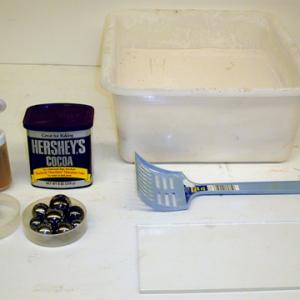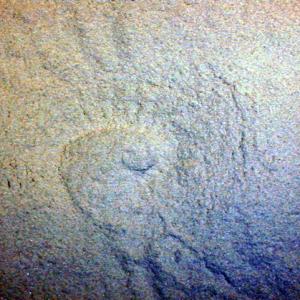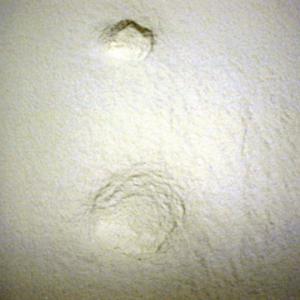College of Liberal Arts & Sciences
8A70.90 - Crater Formation
Make sure the milk drop slides are in the tray in the proper orientation.
The powder mixture for crater formation seems to work best when it consists of 1 part white flour to 1 part granulated sugar. Stir the mixture before use to break up any mixture hardening due to settling. Smooth with the Plexiglas plate and then sprinkle a layer of cocoa or cinnamon on top. This helps bring out the crater features and splatter definition. Throw ball bearings at the mixture at varying angles. A variety of sizes may be used, however the 1/4 inch ball bearing seem to give the best crater formation representation.
- Elizabeth Kutsche and Anthony P. French, "Why the Crown?", TPT, Vol. 27, #2, Feb. 1989, p. 118.
- S. Kasas, G. Dumas, and G. Dietler, "Impact Cratering Study Performed in the Laboratory Without a Fast Recording Camera", AJP, Vol. 68, #8, Aug. 2000, p. 771.
- Runchen Zhao, "Raindrops Imprints and Asteroid Strikes", Physics Today, Vol. 68, #3, Mar. 2015, p. 72.
- Eric Hand, "World's Oldest Impact Crater Dated in Australian Outback", Science, Vol. 365, #6456, Aug. 2019, p. 852.
- Luigi Folco, Mario Di Martino, Ahmed El Barkooky, Massimo D'Orazio, Ahmed Lethy, Stefano Urbini, Iacopo Nicolosi, Mahfooz Hafez, Carole Cordier, Matthias van Ginneken, Antonio Zeoli, Ali M. Radwan, Sami El Khrepy, Mohamed El Gabry, Mahomoud Gomaa, Aly A. Barakat, Romano Serra, and Mohamed El Sharkawi, "The Kamil Crater in Egypt", Science, Vol. 329, #5993, Aug. 2010, p. 804.
- Michael C. Malin, Kenneth S. Edgett, Liliya V. Posiolova, Shawn M. McColley, and Eldar Z. Noe Dobrea, "Present-Day Impact Cratering Rate and Contemporary Gully Activity on Mars", Science, Vol. 317, #5805, Dec. 2006, p. 1573.
- "For Word Nerds", Uncle John's Bathroom Reader, p. 269.
- Jearl Walker, "2.147. Granular Splashing", The Flying Circus of Physics Ed. 2, p. 144.
- Jearl Walker, "4.113. Splashing Milk Drops", The Flying Circus of Physics with Answers, p. 108, 264.
- Janice VanCleave, "20. Splatter", 202 Oozing, Bubbling, Dripping, & Bouncing Experiments, p. 13.
- Janice VanCleave, "28. Blasters", 201 Awesome, Magical, Bizarre, & Incredible Experiments, p. 15.
- Janice VanCleave, "57. Splatter", Astronomy for Every Kid - 101 Easy Experiments That Really Work, p. 124 - 125.
- Janice VanCleave, "53. Plop!", Astronomy for Every Kid - 101 Easy Experiments That Really Work, p. 116 - 117.
Disclaimer: These demonstrations are provided only for illustrative use by persons affiliated with The University of Iowa and only under the direction of a trained instructor or physicist. The University of Iowa is not responsible for demonstrations performed by those using their own equipment or who choose to use this reference material for their own purpose. The demonstrations included here are within the public domain and can be found in materials contained in libraries, bookstores, and through electronic sources. Performing all or any portion of any of these demonstrations, with or without revisions not depicted here entails inherent risks. These risks include, without limitation, bodily injury (and possibly death), including risks to health that may be temporary or permanent and that may exacerbate a pre-existing medical condition; and property loss or damage. Anyone performing any part of these demonstrations, even with revisions, knowingly and voluntarily assumes all risks associated with them.


